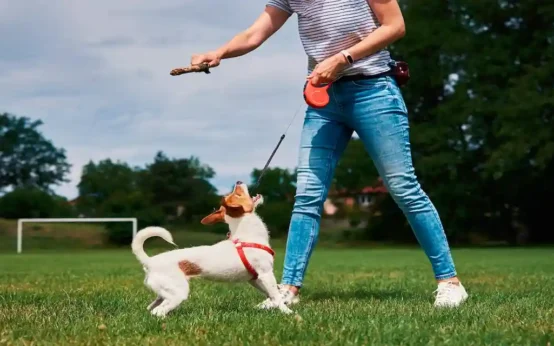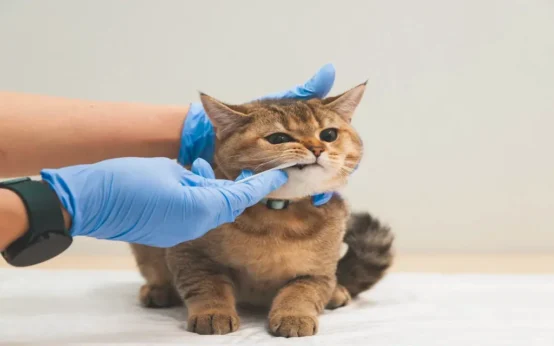What makes a dog light up? You do. This guide shares simple, science-backed steps for how to keep your dog happy every single day. A happy dog behaves better, lives longer, and bonds deeply with their people. The plan is practical for puppies, adults, and seniors.
You will get four clear parts you can use right away, even with a busy schedule: a daily routine you can stick with, health basics that support mood, play and training to fire up the brain, and smart stress relief. The tips are short, clear, and easy to follow. Mix and match, then watch your dog relax and shine.
Let’s build a life your dog loves.
Daily routine: how to keep your dog happy every day
A steady routine is calming for dogs. It tells them what comes next, which lowers stress and boosts trust. Use these small daily anchors, then stay flexible based on weather, your schedule, and your dog’s age.
Morning and evening walks that allow sniffing and reduce stress
Plan two 20 to 30 minute walks most days. Use the 5-5-5 idea. Start with 5 minutes of slow sniffing. Add 5 minutes of simple training like sits and turns. Finish with 5 minutes of relaxed strolling at your dog’s pace.
Sniffing is mental work. It empties stress and improves sleep. Use a sturdy 4 to 6 foot leash, a flat collar or harness, and reflective gear at dawn or dusk. For puppies and seniors, keep the pace easy and the distance shorter. In heat or ice, go shorter or pick indoor play instead.
Mealtime routine and feeding enrichment for a happier dog
Feed most adult dogs twice a day at set times. Puppies do better with 3 to 4 smaller meals. Use slow feeders, snuffle mats, or scatter feeding on a clean floor to slow gulping and make meals fun.
Save a portion of food for 3 to 5 minutes of training during the day. To avoid begging, skip table feeding, use a clear wait cue, and reward calm when you sit down to eat. Keep the rules steady so your dog understands them.
Rest, naps, and calm time so your dog does not get overstimulated
Puppies need 18 to 20 hours of sleep. Adults need 12 to 14. Seniors may need even more. Set up a quiet zone with a comfy bed, white noise, and low foot traffic. This helps the brain reset.
Watch for signs of an overtired dog. Look for zoomies, mouthy behavior, whining, or trouble settling. Help your dog reset with a 10-minute sniff walk, a stuffed chew, or a soft massage behind the ears. Calm builds on calm.
Alone time training and a cozy crate or den
Teach alone time in tiny steps. Start with 1 to 2 minutes while you’re home, then build up. Pair the crate or pen with a stuffed Kong, a LickiMat, or a safe chew. Never use the crate as punishment.
Set a camera to check in. Try this 2-week build-up: Week 1, 2 to 5 minutes twice daily, then 10 minutes. Week 2, 15 to 30 minutes, then 45 to 60 minutes with a food puzzle. Aim for comfort on a normal workday.
Food, water, and vet care that boost your dog’s happiness
Good food, clean water, and preventive care keep your dog comfortable and pain free. Comfort makes room for joy. Use these quick checks and schedules to stay on track.
Choose the right diet and portions for age, breed, and activity
Pick a complete and balanced dog food that carries an AAFCO statement on the label. Check your dog’s body condition. You should feel ribs with light pressure and see a waist from above.
Measure meals with a scale or a consistent scoop. Puppies need more calories and frequent feedings. Adults do well with steady portions. Seniors may need fewer calories and extra joint support as advised by your vet. Skip table scraps and avoid fast food changes to prevent stomach upset.
Hydration habits that keep your dog healthy and happy
As a simple guide, most dogs need about 1 ounce of water per pound of body weight each day. Heat, dry air, and exercise raise that need. Keep fresh water in clean bowls, washed daily. Bring travel water on walks and car trips.
Watch for dry gums, lethargy, sunken eyes, or sticky saliva. Call your vet if your dog won’t drink, is vomiting, or shows sudden changes in thirst. Hydration supports joints, digestion, and energy.
Preventive vet care, vaccines, and parasite protection
Book yearly wellness visits for healthy adult dogs. Seniors or dogs with health issues do best with twice-yearly checkups. Your vet will guide you on core vaccines, timing, and any extras based on your area.
Use monthly parasite control for fleas, ticks, and heartworm if your location needs it. Start preventives early and stick with them. Early care prevents pain, protects family health, and saves money later.
Grooming and dental care for comfort and long-term health
Brush short coats weekly and longer coats several times a week to prevent mats. Bathe as needed based on activity level and coat. Trim nails every 2 to 4 weeks so they don’t click on floors or change posture.
Protect the mouth. Brush teeth 3 to 4 times weekly with dog-safe paste. Add dental chews and schedule vet cleanings when needed. Pain from mats, long nails, or bad teeth wrecks mood and reduces play.
Play, training, and mental games that make your dog happy
Short, fun sessions beat one long grind. Ten minutes of training or brain games can change the whole day. Balance physical play with mental work so your dog is pleasantly tired, not wiped out.
Positive reinforcement you can practice in 10 minutes a day
Pick a marker word, like “yes,” or use a clicker. Mark the exact moment your dog does the right thing, then reward with a tiny treat. Keep reps short and upbeat.
Focus on three cues, sit, down, and come. Add a calm behavior like a mat settle. Practice in quiet spots first, then add small distractions. Success builds confidence, and confidence fuels joy.
Puzzle toys and scent games to beat boredom at home
Start simple with a snuffle mat. Move to a Kong stuffed with kibble and yogurt, then try a muffin tin with tennis balls covering treats. A cardboard box search adds a fun mess your dog can handle.
Freeze stuffed toys for longer sessions. Try a scent game: place three cups, hide a treat under one, and let your dog choose. Rotate puzzles so the challenge stays fresh and rewarding.
Fetch, tug, and safe off-leash fun for different energy levels
Teach safe tug. Start on cue, drop on cue, then pause to calm. Reward the drop with a quick restart. Keep fetch short and happy. Use rolling fetch in hallways for low impact. For seniors, pick soft tosses and grassy ground.
Practice recall with a long line in open fields or fenced areas. Stop before your dog is tired. Watch joints, shorten sessions in heat, and offer water breaks. Fun should leave your dog wanting more.
Socialization and dog park manners for positive play
Good play looks wiggly, balanced, and loose. Dogs take turns, pause for brief breaks, then return to play. Stiff bodies, pinning, or nonstop chasing mean it is time to pause or leave.
At parks, enter during quieter times, keep first visits short, and avoid toy-guarders and bullies. Safer options include parallel walks or small meetups with known friendly dogs. For puppies, focus on calm greetings and new surfaces and sounds, not endless play.
Reduce stress and build trust for a truly happy dog
Stress can hide in plain sight. Learn to spot early signs and make calm a daily habit. Small changes at home help your dog feel safe and understood.
Read dog body language to spot joy and stress fast
Happy signs include soft eyes, a loose tail at mid-height, and a relaxed jaw. Stress signs include whale eye, a tucked tail, lip licking when no food is present, yawns in odd moments, or shake-offs after no wetness.
When you see stress, pause and lower the intensity. Add distance from the trigger, slow your voice, and give a simple cue your dog knows well. Then reward calm. Clear reading prevents bigger problems.
Separation anxiety basics: short practice and calm goodbyes
Train tiny departures that stay below your dog’s panic point. Step outside for seconds, return before worry starts, then slowly add time. Keep exits and returns calm and boring.
Offer a food puzzle during departures. Avoid long, emotional goodbyes. Red flags include howling, drooling puddles, damage near doors, or escape attempts. If you see these, get help from a qualified pro.
Create a safe home, smooth travel, and calmer vet visits
At home, use baby gates to manage space, remove unsafe cords, and choose pet-safe plants. Give your dog a stable spot to rest away from household noise.
For car rides, use a crash-tested crate or harness. Start with short happy drives to the park, not only to the vet. Practice gentle handling at home, touch paws and ears, then treat. Bring high-value snacks and a familiar mat to the clinic to lower fear.
When to call a trainer or vet behaviorist
Reach out if you see panic when left alone, biting, nonstop barking, growing aggression, self-harm, or sudden behavior change. A positive reinforcement trainer teaches skills and builds good habits. A vet behaviorist can diagnose medical or clinical behavior issues and prescribe meds if needed.
Early help protects welfare and brings relief faster. You do not have to solve this alone.
Conclusion
Happiness rests on four pillars: a steady routine, smart health care, daily play and training, and stress relief. Small steps each day make the difference. To get started, try this simple 7-day plan.
- Day 1: Long sniff walk with the 5-5-5 plan.
- Day 2: New puzzle toy or stuffed Kong.
- Day 3: Brush coat and do a nail length check.
- Day 4: Ten minutes of training with a marker word.
- Day 5: Social walk with a calm dog friend.
- Day 6: Crate practice and 20 minutes of quiet time.
- Day 7: Prep for a vet visit, weigh your dog, update notes.
Build from there, and you will see brighter eyes and calmer rest. You now know the core of how to keep your dog happy. Ready to try one step today? Share your dog’s win in the comments and help another pet parent get started.
Related post: Simple Tricks for Stopping Hiccups in Dogs
FAQ:
How much exercise does my dog need each day?
Most adult dogs need 45 to 90 minutes. Herding and working breeds often need more. Break it into walks, play, and training. Puppies and seniors need shorter, gentler sessions.
What kind of mental enrichment keeps dogs content?
Rotate puzzle feeders, snuffle mats, and scent games. Short training sessions tire the brain. Teach simple tricks, play hide-and-seek, or try food-stuffed chew toys.
How do I know if my dog is happy?
Look for loose body language, soft eyes, and a wag that moves the hips. They eat well, sleep soundly, and engage with you. Happy dogs play, explore, and relax near you.
What are signs my dog is stressed or bored?
Pacing, whining, lip licking, yawning, and pinned ears are common. Destructive chewing and excessive barking point to boredom. Reduce triggers, add exercise and enrichment, and train calm behaviors.
How should I feed for health and mood?
Choose a complete, balanced diet that fits age and size. Keep a steady feeding schedule. Watch weight and stool quality. Ask your vet before changing food or adding supplements.
Do dogs need a daily routine?
Yes, predictable events lower anxiety. Keep set times for meals, walks, play, and rest. Use the same cues for outings and bedtime.
How much sleep is normal?
Puppies sleep 18 to 20 hours a day. Adults sleep 12 to 14 hours. Seniors may nap more. Offer a quiet, cozy spot away from foot traffic.
What training boosts happiness?
Reward-based training builds confidence and trust. Teach sit, stay, come, and leave it. Keep sessions short, fun, and clear. End on a win.
How often should my dog see the vet?
Once a year for healthy adults, twice for seniors or dogs with issues. Keep vaccines, heartworm tests, and parasite prevention up to date. Dental checks matter too.
What grooming habits improve well-being?
Brush as needed by coat type. Keep nails short to prevent pain. Clean ears and brush teeth several times a week. Bathing depends on activity and skin.
How do I make alone time easier?
Start with short absences and build up. Give a long-lasting chew or a food puzzle before you leave. Keep goodbyes and returns calm. If panic shows, call a trainer or vet.
What toys are worth buying?
Pick toys that match chewing strength and play style. Rotate a few each week to keep interest high. Supervise with new or edible toys. Replace damaged items fast.
How do weather and seasons affect happiness?
In heat, walk early or late, offer shade and water. In cold, use a coat for short-haired dogs. Protect paws from salt and hot pavement. Adjust exercise to conditions.
How can I help a shy or reactive dog feel safer?
Give them space from triggers, then work at a distance they can handle. Pair sights and sounds with treats. Use a harness and clear cues. Seek a certified trainer for a plan.
What do senior dogs need to stay happy?
Short, frequent walks, soft bedding, and low-impact games. Adjust food for weight and joint health. Add ramps or rugs for traction. Pain control keeps spirits up.
How do I keep peace in a multi-dog home?
Feed separately, rotate high-value chews, and set clear rules. Give each dog one-on-one time. Watch body language and step in early if tension rises.
Is social time with other dogs necessary?
Quality beats quantity. Some dogs love play, others prefer people. Choose well-matched playmates and brief meets. Skip crowded parks if your dog feels uneasy.
What quick daily habits boost happiness?
Five-minute training, two short sniff walks, and one brain game. A calm chew after dinner. Gentle check of paws, ears, and coat. End the day with cuddles if your dog likes touch.
How do I make my home more dog-friendly?
Provide a safe retreat, stable routines, and clear potty access. Use baby gates where needed. Store food and meds out of reach. Keep floors grippy for older dogs.
On a budget, what brings the most joy?
Daily walks, simple sniff games, and DIY food puzzles. Teach tricks with kibble. Rotate a few sturdy toys. Your time and attention matter most.




 Dog Trick Training for Beginners
Dog Trick Training for Beginners  Gingivitis Cats Symptoms Every Pet Parent Should Know
Gingivitis Cats Symptoms Every Pet Parent Should Know  How to Make Dog Cookies at Home
How to Make Dog Cookies at Home  Wet Food or Dry Food for Cats?
Wet Food or Dry Food for Cats?  What Is the Healthiest Hamster Breed for Your Home?
What Is the Healthiest Hamster Breed for Your Home?  Cat Food Intolerance Symptoms: How To Spot Them Early
Cat Food Intolerance Symptoms: How To Spot Them Early